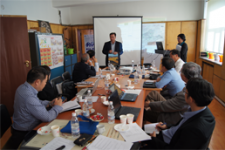The Asia-Pacific region is the most disaster-prone region of the world. It continually faces multiple shocks, transcending geographical boundaries and endangering communities and livelihoods. Building resilience to multiple shocks is therefore one of the most pressing challenges for policymakers in the region.
The flagship publication of the United Nations Economic and Social Commission for Asia and the Pacific (ESCAP) entitled “Building Resilience to Natural Disasters and Major Economic Crises” indicated that a more comprehensive and systemic approach to building resilience was needed. ESCAP then presented a regional roadmap at its 69th Commission session.
The Commission has taken many steps to address the challenges of building resilience in multi-dimensional ways. For example, ESCAP has taken the lead at the regional level to strengthen cooperation mechanisms and to implement the historical “Asia-Pacific Plan of Action for Applications of Space Technology and Geographic Information Systems for Disaster Risk Reduction and Sustainable Development", 2012-2017.
As a way to promote the use of space-based technology and GIS in disaster risk reduction, ESCAP has provided more than 150 near real-time satellite images and damage maps to countries affected by severe disasters within the last two years. These maps were provided in the framework of ESCAP’s long-standing Space Application Programme for Sustainable Development (RESAP).
The flagship project under RESAP is the Regional Mechanism for Drought Monitoring and Early Warning. ESCAP will facilitate the provision of space-based data, products, and services generated by the regional service nodes in China and India, and will strengthen capacities of Member States to address agricultural droughts. The Mechanism is operational in five pilot countries (Mongolia, Sri Lanka, Cambodia, Nepal, and Myanmar) and it will extend the service to Central Asia.
Moreover, ESCAP’s Space Application Programme gives high priority to capacity building in developing countries. Approximately 380 policymakers and practitioners from more than 30 Member States were enabled to effectively use space and GIS applications. Additionally, ESCAP has conducted research and policy analysis of emerging needs and challenges based on a regional inventory of space-based technology application capabilities in Asia and the Pacific region.
Conscious of the “One UN” spirit, ESCAP is delivering these activities in close collaboration with UNOSAT, UN-SPIDER, UNDP, and UNISDR, as well as with regional initiatives such as the Asia-Pacific Space Cooperation Organization, Sentinel Asia, the Centre for Space Science and Technology Education in Asia and the Pacific, the Applied Geoscience and Technology Division of the Secretariat of the Pacific Community, the Asian Institute of Technology and the Regional Integrated Multi-Hazard Early Warning System for Africa and Asia.
On a final note, building resilience requires urgent attention. It is imperative that policymakers, communities and the private sector work together to weave resilience into economic, social and environmental policies. As the regional arm of the United Nations, ESCAP provides a multilateral platform to share knowledge, to engage in policy dialogue and to build consensus towards the goal of achieving inclusive, sustainable and resilient development in Asia and the Pacific.
Read more: www.unescap.org

